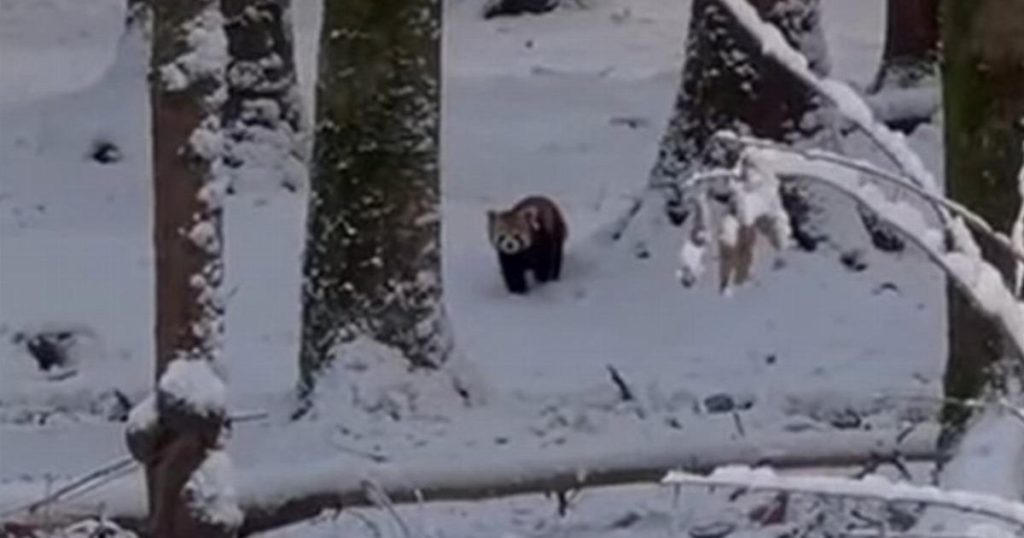Two mischievous red panda cubs, Li and Yen, orchestrated a daring escape from their enclosure at Walter Zoo in Switzerland, capitalizing on a heavy snowfall that reshaped their habitat. The weighty snow caused plants within their enclosure to collapse, inadvertently creating an escape route for the adventurous duo. This unexpected turn of events set off a flurry of activity at the zoo, as staff mobilized to locate and retrieve the escapees.
The search began immediately, with zookeepers following the clear tracks left by the pandas’ tiny paws in the fresh snow. Li, the first of the two cubs, was found relatively quickly. Her tracks led the search party to an enclosure housing vicuñas, where she was discovered lounging seemingly unconcerned by the commotion she had caused. Locating Yen, however, proved to be more challenging. Her paw prints led the search team beyond the zoo’s perimeter and into the surrounding forest, indicating a more ambitious escape.
Yen’s journey into the wilderness was briefly documented on video, showing her confidently strolling through the trees until the moment she spotted her pursuers. Her confident stride immediately transformed into a frozen stance as she seemingly assessed the situation. With the assistance of Switzerland’s K-9 Animal Search team and a helpful pedestrian, zoo staff were able to track Yen down. Armed with a net, they pursued the fugitive cub and successfully captured her, bringing an end to her brief taste of freedom.
Upon their return to the zoo, both Li and Yen underwent thorough medical examinations to ensure their well-being after their escapade. Fortunately, both cubs received a clean bill of health, allaying any fears about potential injuries or illnesses contracted during their time outside the enclosure. The incident highlighted the resourcefulness and adaptability of these small creatures, as well as the dedication and efficiency of the zoo staff and local search teams in ensuring their safe return. The pandas were subsequently returned to their enclosure, their adventure concluded, though undoubtedly a memorable tale for both the animals and the zoo staff.
This incident also provides an opportunity to explore the fascinating world of red pandas. Contrary to popular belief, red pandas are not closely related to giant pandas. While giant pandas belong to the bear family, red pandas occupy their own distinct taxonomic family, Ailuridae, sharing closer kinship with raccoons, weasels, and skunks. Interestingly, red pandas predate giant pandas in terms of scientific classification, having been named "panda" first by French zoologist Frédéric Cuvier in 1825, over four decades before the discovery of giant pandas in 1869.
Despite their differing lineages, both panda species share a fondness for bamboo. In fact, bamboo constitutes a staggering 98% of a red panda’s diet, with these small mammals consuming up to 20-30% of their body weight in bamboo daily. Nicknamed the "red bear-cat," red pandas are known for their arboreal lifestyle and their propensity for sleep, often spending up to 17 hours a day, or two-thirds of their time, slumbering. These charismatic creatures measure approximately 50-60 centimeters in length and typically weigh between three and five kilograms. Their distinctive reddish-brown fur, long, bushy tails, and small, rounded ears contribute to their unique appearance.
Walter Zoo, home to the adventurous Li and Yen, is located near the historic city of St. Gallen in northeastern Switzerland. Established in 1961, the zoo boasts a diverse collection of over 900 animals representing approximately 130 different species. The incident with the escaped red pandas underscores the challenges and rewards of caring for these captivating creatures in a zoo environment. The zoo’s swift response and successful recovery of the pandas demonstrate their commitment to animal welfare and their expertise in managing such situations. This incident serves as a reminder of the importance of continuous vigilance and adaptation in maintaining the safety and well-being of animals under human care, especially in the face of unpredictable environmental changes.




